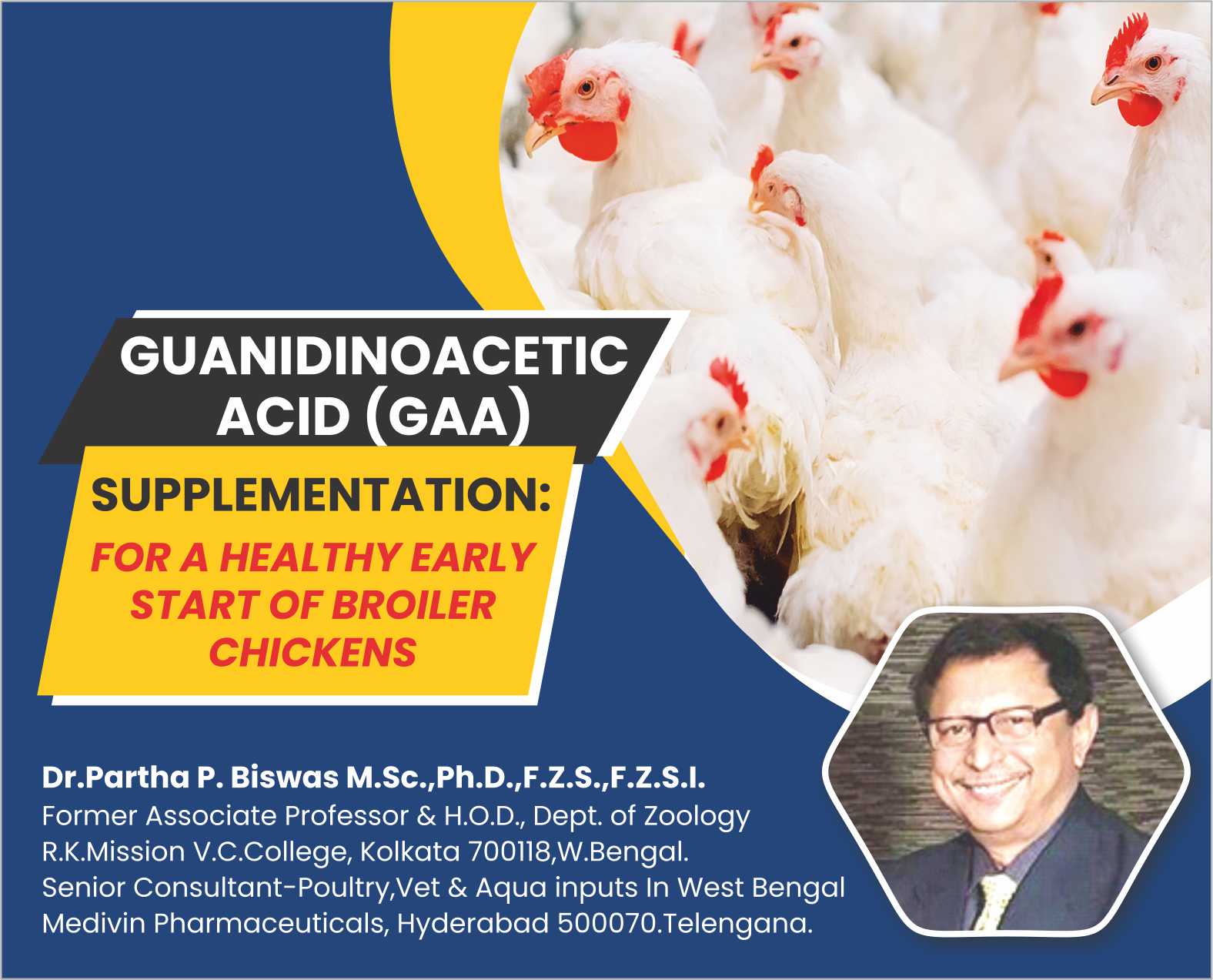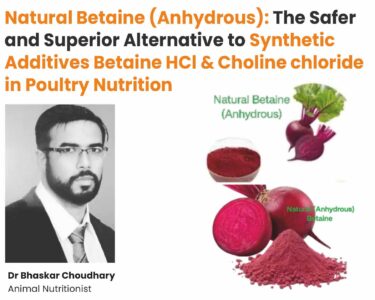Guanidinoacetic Acid (GAA) Supplementation: For A Healthy Early Start of Broiler Chickens
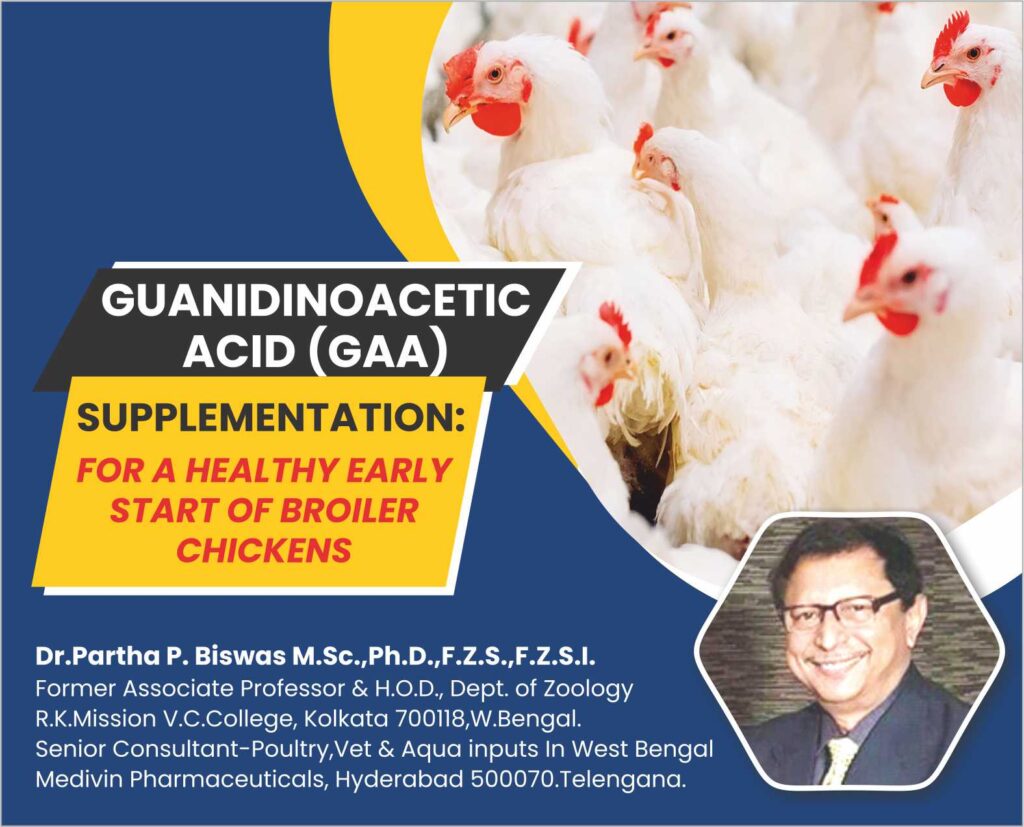
Introduction
Poultry nutritionists must search for ways to lower the overall cost of feed as the price of dietary energy sources continues to rise steadily. As a result, they have at times opted to incorporate lower-quality energy feed ingredients as a solution to this problem. These methods may cause the birds to perform poorly in terms of feed conversion ratio, body weight gain, and overall low productivity. Feathered creatures are by nature omnivores that are designed from an early age to consume both plant and animal materials. But for several reasons, the diet of chickens is increasingly changing to a vegetarian diet. This change caused the loss of some important entities, such as creatine, a key substance in meat that is not found in plants. Creatine is a crucial compound for cellular energy production. Creatine phosphate is the primary substance responsible for supplying ATP, the cell’s energy source. When creatine is not obtained through diet, the body’s creatine levels decrease and must be replenished through endogenous amino acid synthesis. Poultry farming has experienced significant growth in recent years, with poultry production increasing by nearly four times since 1957. This growth has been primarily driven by the rise in carcass (+12%) and breast meat production (+50%). What if we could enhance embryo development by providing a readily available energy source to improve hatchling survival and the first days of life? This can be achieved by supplementing broiler breeders with creatine. Creatine enables muscle cells to generate additional energy by converting low-energy ADP back into ATP. While creatine is naturally present in muscle tissue and animal-derived foods, the concentrations in animal proteins can vary widely due to the quality of raw materials and the instability of creatine under harsh processing conditions. Moreover, animal protein is seldom included in animal feed, as most bird feed is composed of plant proteins and grains.
Benefits of Creatine Forerunner
Even though birds have the ability to produce their own creatine, the amount generated is insufficient to meet the demanding growth and performance needs of modern broilers. The early stages after hatching are crucial for the development of efficient broilers, as they require a significant amount of energy. This is why creatine plays a vital role in this process. While creatine can be transferred from the hen’s diet and synthesis to the egg, the levels passed on are typically low. By supplementing broilers with creatine, we can ensure that the embryo receives an additional energy reserve that can be utilized post-hatching. However, creatine is sensitive to heat and can be lost during the preparation of bird feed supplements.
A strategic solution is to include the creatine precursor guanidinoacetic acid (GAA) in the mix, which supports optimal nutritional conditions. GAA is converted to creatine in the liver and stored in muscle tissue, making it a valuable addition to animal feed for broilers.
Effects of Maternal Nutrition on Hatchability
New research from Israel has revealed significant findings that support the transfer of creatine from chicken to chicken when GAA (creatine precursor) is added.
Some research indicates that supplementing broilers with GAA may impact the accumulation of creatine in laying hens. The addition of GAA to chicken feed has been proven to boost the creatine levels in both egg yolk and albumin, with the most noticeable impact seen in the yolk, which is crucial for embryo development. By including dietary GAA (0.15%), the creatine content of the entire egg can be increased by over 40%.
GAA: What does it ENTAIL?
Natural amino acid derivative guanidinoacetic acid (GAA) is widely known for its pivotal function in the manufacture of creatine, a vital substance involved in the metabolism of cellular energy. GAA, sometimes referred to as betacyamine or glycocyamine, has been studied as a dietary supplement for increasing energy. In vertebrate animals, GAA is the sole direct precursor that produces creatine. Glycine and arginine are the building blocks for the synthesis of GAA, a metabolic intermediate product that is mostly produced in the kidney and pancreas. GAA is converted to creatine by methylation once it reaches the liver. In the creatine biosynthesis pathway, the primary regulated and rate-limiting step is the synthesis of GAA from arginine and glycine. Interestingly, this synthesis is accomplished in different organs, the first step (synthesis of guanidinoacetic acid from arginine and glycine) taking place in the kidney, the second one (synthesis of creatine from guanidinoacetic acid) in the liver. Thus, guanidinoacetate is synthesized in the kidney, and then transported to the liver where it is converted to creatine, which is then transported to its destination organs.
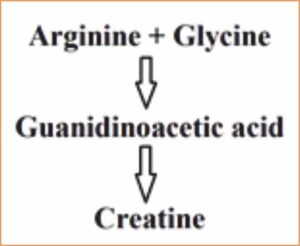
GAA Biosynthesis
The synthesis of guanidinoacetate requires two amino acids, arginine and glycine. Arginine transfers its amidino group to the amino group of glycine to produce ornithine and GAA, catalyzed by L-arginine: glycine amidino transferase (AGAT). Guanidinoacetate is then methylated by the methyl group of S-adenosylmethionine (SAM), which is synthesized from methionine. This reaction produces creatine and S-adenosylhomocysteine (SAH) and is catalyzed by guanidinoacetate N-methyltransferase (GAMT). Creatine synthesis is an inter-organ metabolic process, with GAA synthesis occurring primarily in the kidney and GAA methylation occurring primarily in the liver. The addition of GAA for creatine synthesis imposes a methylation demand on the body because creatine synthesis is considered to be the major user of methyl groups from SAM (S-adenosyl methionine). Thus, methyl group of betaines can be used in transmethylation reactions for synthesis of creatine and may reduce the requirement for other methyl group donors such as methionine and choline. Betaine is an osmolyte that helps maintain cellular water homeostasis and serves as a methyl group donor, which are its two main metabolic functions. It has been shown that the antioxidant mechanism of betaine strengthens non-enzymatic antioxidant defenses.
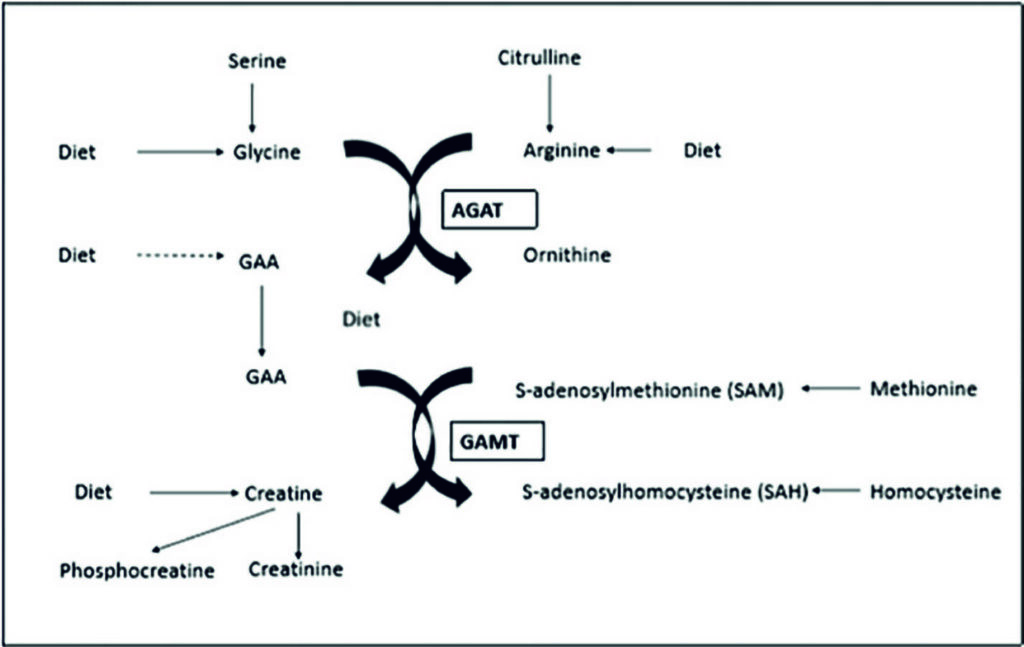
Appropriate GAA Dose
The growth performance of broiler chickens may be successfully enhanced by dietary supplementation of 600-1200 mg/kg GAA. The lowest dose required to boost performance is 600 mg/kg GAA. GAA concentrations up to 1500 mg/kg feed did not affect broiler performance or mortality; However, at 3000 mg/kg feed, food intake and body weight decreased somewhat, although not significantly. Feed intake was significantly affected by the highest level of inclusion (6000 mg GAA/kg feed), resulting in a significant reduction in weight gain. GAA treatment had no apparent effect on mortality or feed efficiency.
Why is GAA Used?
· As a creatine precursor GAA plays an important role in energy metabolism.
– However, due to the instability of creatine in the production process and cost, GAA has been studied as an effective alternative to creatine supplements.
– GAA has been tested as a potential feed additive to improve energy utilization and growth performance in poultry.
– GAA has been combined with methionine to improve growth performance and may also act as an arginine sparing agent in birds.
– GAA supplementation increases growth, reproductive performance and meat quality in poultry.
– Among its many proven benefits, GAA effectively improves feed conversion ratio and animal performance.
– GAA has many roles outside of creatine, including stimulation of insulin secretion, neuromodulation and vasodilation.
– Supplemental GAA improves growth performance in heat-stressed chickens.
– Cold stress is another physical environmental stress that hugely impacts the poultry industry. During commercial broiler production, cool temperatures are the primary cause of ascites and related deterioration of growth performance. Dietary inclusion of 1.2 g/kg GAA and betaine improved FCR in broilers under cold stress, suggesting GAA can be used as an efficient supplement to improve the harmful effects of cold stress in broilers.
– Furthermore, GAA can be utilized as a feed supplement in intensive rearing systems to improve feed efficiency and minimize myopathies in the pectoral muscle.
– Supplemental GAA can be used to enhance the fertility rate and sperm penetration in aged broiler breeder hens, possibly by increasing ATP availability in sperm mitochondria, thereby increasing sperm motility and fertility rate.
– Another way that has the potential to increase the productivity of native chickens is to use betaine. Betaine has an effect as a methyl donor for methionine and its diverse physiological properties can improve the intestinal environment and increase the ability of feed absorption. Accumulation of betaine in cells may protect against osmotic stress.
– GAA is known to have an antibacterial effect.
– GAA is safe and potentially efficacious in poultry nutrition, supporting growth in chickens for fattening.
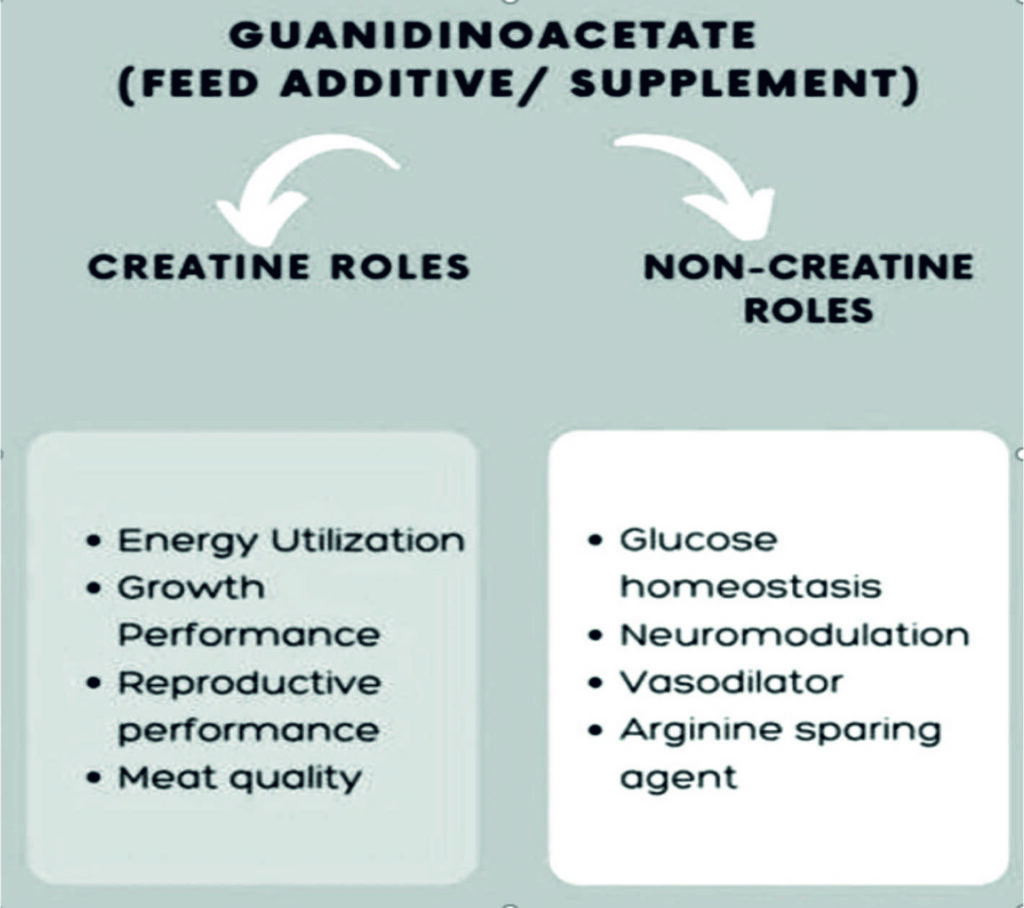
Conclusion
There is a growing body of research dedicated to determining the most effective methods for feeding day-old chicks in order to ensure they develop into healthy, rapidly growing birds. Solutions range from providing small, easily digestible feed pellets to utilizing specially designed feeders that allow young chicks to access their food with ease. Enhancing the nutritional content of eggs with creatine to better align with the physiological needs of modern broilers is a crucial step towards enhancing broiler production in terms of health, growth, and efficiency. Recent studies on using GAA as a creatine source have shown that incorporating GAA into the diet of broiler breeder hens is a practical and efficient approach to achieving this goal.


